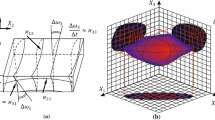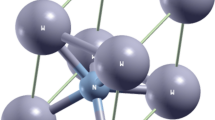Abstract
Simple electronic spectra are considered in the tight-binding approximation for the case of uniform uniaxial deformation. It is shown that there is a range of deformations (considerably exceeding a threshold one) in which conditions for the generation of phonons by nonequilibrium electrons are satisfied. Moreover, in this range an increase in the deformation is accompanied by an increase in the number of pairs of potentially active electronic states. The effect is pronounced more strongly in the case of tensile deformation. The results obtained are important for the development of the theory of reconstructive martensitic transformations.
Similar content being viewed by others
References
L. P. Gor’kov and O. N. Dorokhov, “Superconductivity Properties and Structural Transition in Compounds with an A-15 Lattice”, Zh. Éksp. Teor. Fiz. 71(5(11)), 1934–1950 (1976).
M. P. Kashchenko and R. I. Mints, “Mechanism of Martensitic Transformation Controlled by the Nonequilibrium of the Electron-Phonon System,” Pis’ma Zh. Eksp. Teor. Fiz. 26, 433–435 (1977).
G. V. Kurdjumov, L. M. Utevskii, and R. I. Entin, Transformations in Iron and Steel (Nauka, Moscow, 1977) [in Russian].
M. P. Kashchenko, Wave Model of Martensite Growth upon γ-α Transformation in Iron-Based Alloys (Ural. Izdat. Firma Nauka, Ekaterinburg, 1993) [in Russian].
M. P. Kashchenko, “The Wave Model of Martensite Growth for the FCC-BCC Transformation of Iron-Based Alloys,” arXiv:cond-mat/0601569.
M. P. Kashchenko, N. A. Skorikova, and V. G. Chashchina, “Conditions Required for Nonequilibrium Electrons to Generate Elastic Waves in Metals with a Cubic Lattice,” Fiz. Met. Metalloved. 99(5), 3–13 (2005) [Phys. Met. Metallogr. 99 (5), 447–456 (2005)].
U. Harrison, Electronic Structure and Properties of Solids (Freeman, San Francisco, 1980; Mir, Moscow, 1983).
V. V. Vereshchagin and M. P. Kashchenko, “Principles of Selection of Electronic State Pairs Potentially Active in Phonon Generation,” Fiz. Met. Metalloved. 61(2), 237–244 (1986).
J. C. Slater and G. F. Koster, “Simplified LCAO Method for Potential Problem,” Phys. Rev. 94(6), 1494–1524 (1954).
G. K. H. Madsen and D. J. Singh, “BoltzTrap: A Code for Calculating Band-Structure Dependent Quantities,” arXiv:cond-mat/0602203.
Author information
Authors and Affiliations
Additional information
Original Russian Text © M.P. Kashchenko, N.A. Skorikova, V.G. Chashchina, 2008, published in Fizika Metallov i Metallovedenie, 2008, Vol. 106, No. 3, pp. 229–247.
Rights and permissions
About this article
Cite this article
Kashchenko, M.P., Skorikova, N.A. & Chashchina, V.G. Effect of uniaxial deformation on the number of pairs of inversely populated electronic states. Phys. Metals Metallogr. 106, 219–237 (2008). https://doi.org/10.1134/S0031918X08090019
Received:
Accepted:
Published:
Issue Date:
DOI: https://doi.org/10.1134/S0031918X08090019




